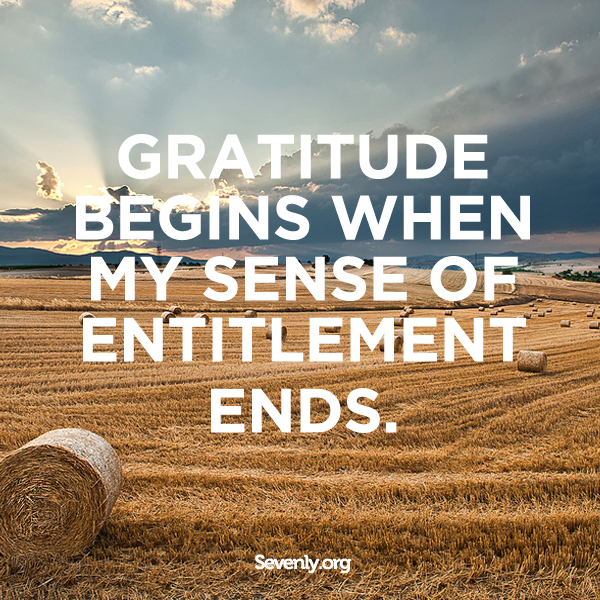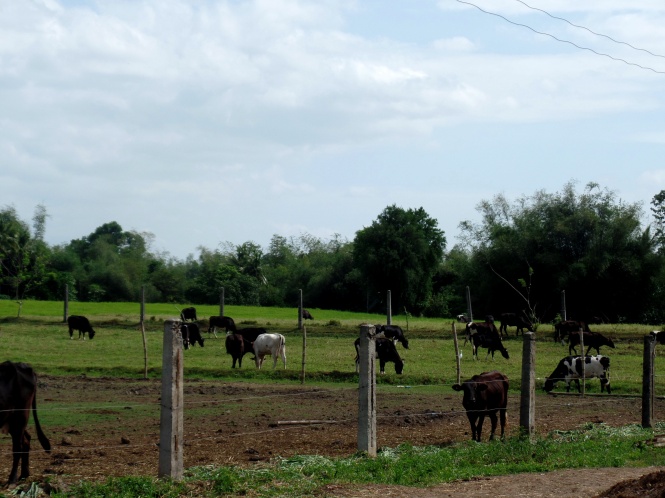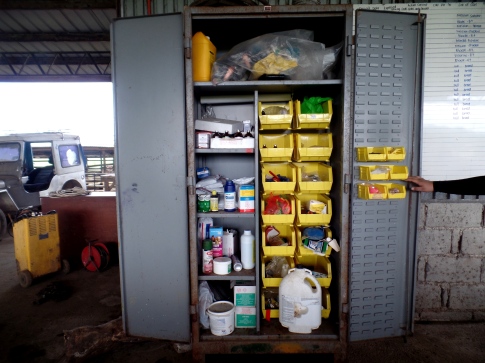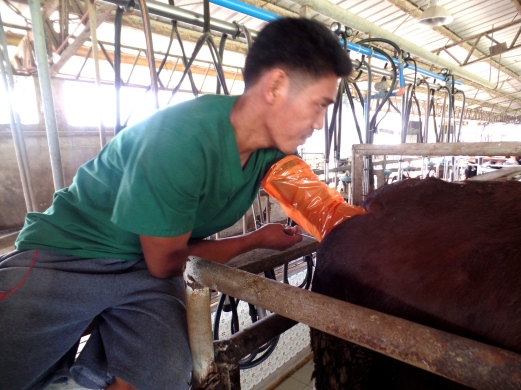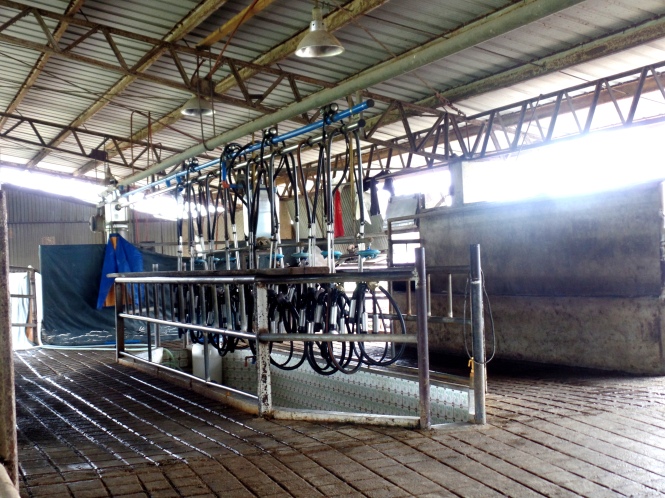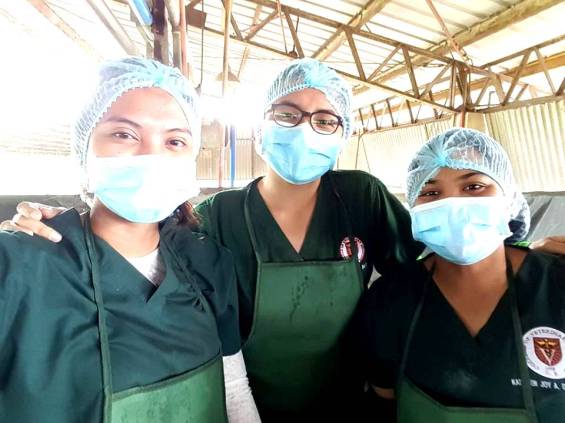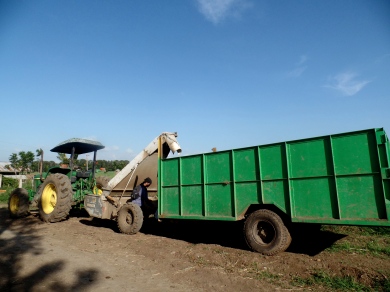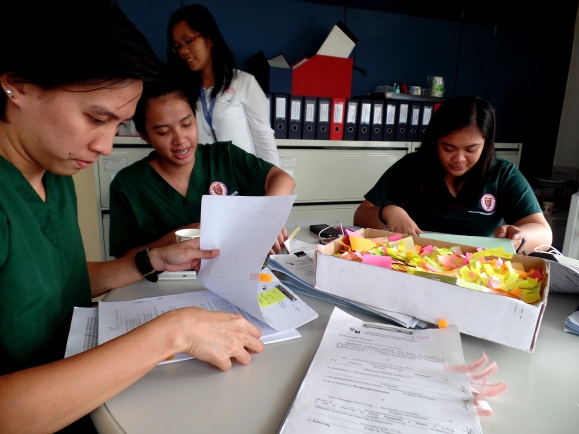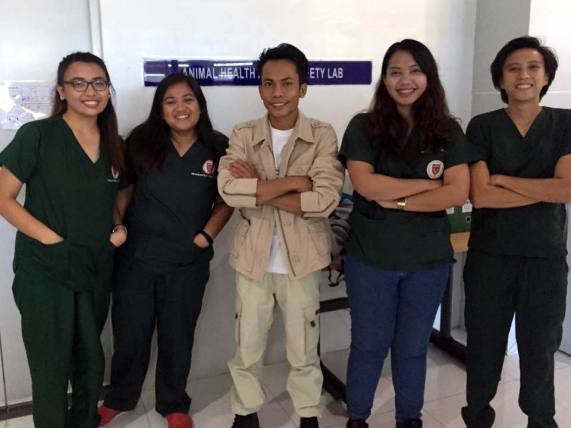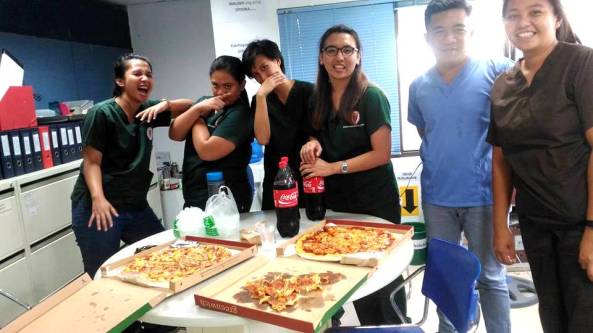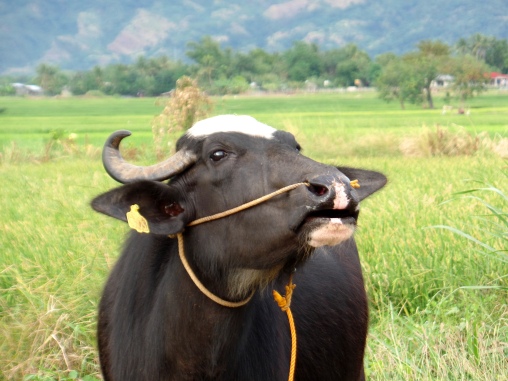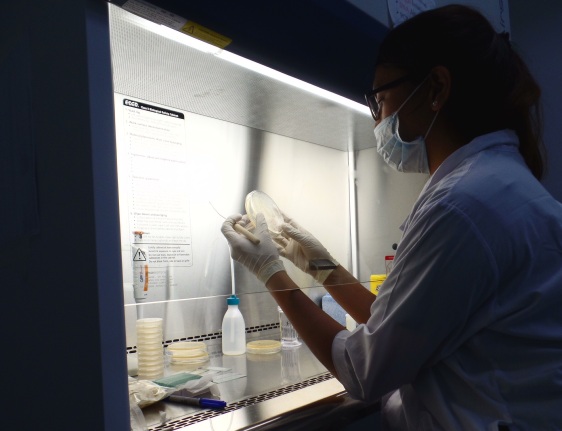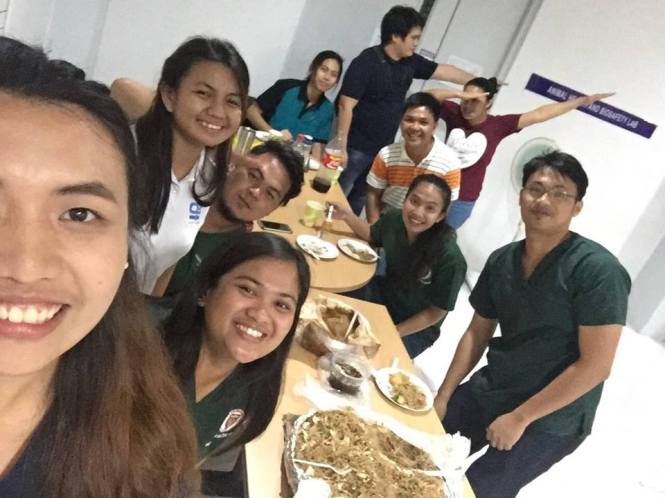Week 2 is here! This week we are assigned at the National Gene Pool (GP) division of PCC. According to their website, this division essentially operates as an “open nucleus herd”, i.e., it allows entry of breeding stocks into a herd of purebred (riverine) dairy buffaloes where systematic breeding, selection, and genetic evaluation procedures are being carried out. Their purpose is to eventually produce an elite herd of dairy buffaloes that would be sources of superior germplasm for future generations. In simple terms, it is here in GP where they mix and match genes in order to make excellent breed of dairy carabaos for the farmers around the Philippines.
Compared to our laboratory week, this week was more physically-demanding which is good because who doesn’t a love a good day’s work out? 🙂
DAY 6. January 23, Monday.
6:30AM. Good Morning, Gene Pool! The road to gene pool farm is quite far (a solid 30-35 minute walk) so we had to start early. Good thing the weather was on our team: it was very windy with a hint of the sun.

Ready for Gene Pool week!

Road to the farm.
8AM. Flag Ceremony. Every Monday, the whole of PCC office is required to attend the flag raising and sir Mark from the HR Department invited us to join them as well. It was nice to see everyone working in PCC for the first time. They have a lot of employees! Also, I realized it has been a long time since I attended a flag ceremony! I missed it!
10AM. Farm rounds. Doc Jim Candelaria, one of the gene pool veterinarians, had a meeting in the morning so he tasked us to roam around the GP farm and list down if there were downer animals or any abnormalities we may see.
11:30. Farm overview. Doc Jim arrived from his meeting. He gave us a tour around the whole farm and explained the farm protocol and other farm fundamentals. As of counting, the facility maintains 609 purebred dairy buffaloes (422 Bulgarian and 187 Brazilian). He taught us how the animals were identified. The ear tag on the left ear shows 5 numbers. The first two numbers indicate the year the animal was born while the following 3 numbers indicate the order of which its birth for that year. Gene Pool also developed their own system of identifying their animals and is placed in the right ear. It is composed of one letter followed by three numbers. The letter indicates the year it was born: A- 2013, B – 2014, B – 2015 and so on. The next 3 again indicates the order of which the animal was born that year.
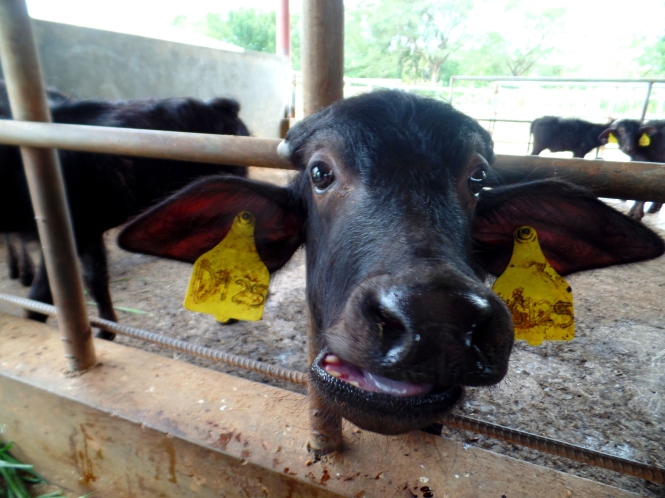
For instance the calf above has the numbers “16125” on its left ear tag which means it was born on the year of 2016 and it is the 125th calf born that year. The ear tag on its right says the same thing.
The calf protocol are as follows:
- 1st day: Seperate immediately from the dam. Place ear tag.
- 3rd day: Iron supplement administration
- 7th day: Dewormer administration
- 10th day: Anticoccidial administration
- 90th day: Hemorrhagic septicemia vaccination
- 104th day: 2nd shot of HemoSep
The farm has 7 houses with almost 600 heads of Water buffaloes. Each of the houses were further subdivided into pens of different categories as well. There were also cattle present on the farm used for research purposes.
1PM. Patient treatment. Animal no. 2GP138 was said to be recovering from pneumonia. It has been a downer since December 2016 and has been isolated in an individual pen since then. Upon examination, it was lethargic, cannot stand on its own but it had good appetite. We attached the animal in a scow lifter/sling to help it stand up on its own.

Define heavy!

Success!
As we were doing rounds, we observed an animal to be limping. It also has crossed- forelimb conformation when standing. Doc Jim taught us how to administer a drug intramuscularly at the neck- shoulder area just rostral to the scapula. We administered Dexamethasone, an anti-inflammatory drug, synthetic analogue of prednisolone. It has a similar but more potent anti-inflammatory therapeutic action and diversified hormonal and metabolic effects. In bovine, Dexamethasone may be used as supportive therapy in inflammatory conditions, such as arthritic conditions, snake bite, acute mastitis, shipping fever, pneumonia, laminitis, and retained placenta.
2PM. Milking. Milking is done everyday at 9AM and 2PM. We toured around the milking parlor and even tried how to attach the suction cups in the caracow’s udders. Prior to milking, the animals are bathed with high-pressure water to remove mud and other dirt in their body. They are then placed in a milking parlor. The type of parlor they use is a side opening (tandem) parlor. Side opening parlors are usually located on the end of a holding area with two entrance lanes similar to herringbone and parallel parlors. A gate at the entrance point between the holding area and the milking parlor holds the cow until an empty stall is ready. The parlor may be organized to allow the cows to exit in return lanes on either side of the operator area or cross over to a single return lane on one side.

Tandem Milking Parlor

Tandem Milking Parlor
The teats are cleaned with wash cloth and suction cups are then attached. On the average, one caracow produces 3-4 liters per milking and they are milked twice a day giving a total of 6-8 liters per day. After suction, iodine solution is used to wash the teats to prevent mastitis.
3:30PM. Feeding the calves. A part of the milk freshly collected will be brought to the calf barn to give it to the calves. The milk gallon is first placed in a warm water bath to make sure the milk is not too cold for the calves’ stomach. We bottle fed those which are very young. It was the most enjoying activity of the day because the calves were too cute!
4PM. Vermicompost Making. Vermicompost is the product of the composting process using various worms of which earthworms are the most common. This is to create a heterogeneous mixture of decomposing vegetable or food waste, bedding materials, manure and other organic materials. Since vermicompst contains a lot of water-soluble nutrients, it is an excellent and nutrient-rich soil conditioner.
Kuya Jonathan, an expert in vermicompost making, showed us how he makes them. The fecal material produced by a 600-head farm is no joke and I really think vermicomposting is such an intelligent way to make use of it.

Vermicompst Making

Kuya Jonathan teaching us the basics
5PM. Milking the cow. A herd of cattle is present at the carabao farm for research purposes. Doc Jim instructed us to manually milk one pregnant cow since it needs to release its milk to prevent mastitis. This is one of the activities I am looking forward to! Doc Jim taught us how to properly milk the udder manually. We were even able to bring home almost three full bottles.
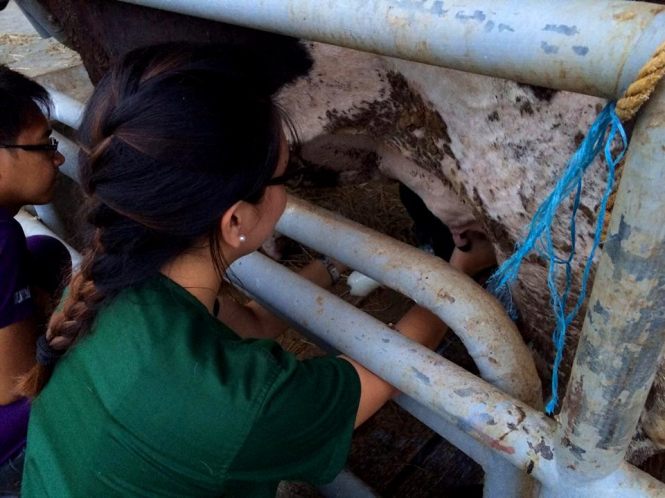
Day 7. Januray 24, Tuesday.
8AM. Farm rounds. Doc Cyril instructed us to do rounds around the farm: check for downers, check the feeds and other occurrences.
9:30AM. Patient treatment. We checked animal no. 2GP138, the animal recovering from pneumonia. We named it “Theodore” because of no apparent reason. Its appetite was still good but it still cannot stand on its own. We placed it again in the cow lifter. It takes the strength 7 people to put it in the sling! Wounds and bed sores were also present all over its body so we sprayed chlortetracycline hydrochloride wound spray and permethrin.
Chlortetracycline is an antibiotic produced by some strains of Streptomyces aureofaciens. It works by inhibiting protein synthesis (elongation). It is said to be effective against Gram-positive and to a lesser degree Gram-negative bacteria than tetracycline. This is used ot prevent bacteria from multiplying and cause further damage. Permethrin, on the other hand, act on the membrane of nerve cells blocking the closure of the ion gates of the sodium channel during re-polarization. It is used to prevent flies, maggots, ticks and other insects to infest the wounds.

Wound Sprays

Paint it blue!
In the afternoon, we removed Theodore from the sling. It is able to stand but can hardly walk. We tried pushing and pulling it. I think Theodore was able to walk for more or less 3 steps.
10:30AM. Meeting the goats! PCC also has a goat farm! Their pens were very clean and the goats all looked healthy. Mang Gerry, the pen’s farm boy, allowed us to feed the goats and even taught us how to drive “kuliglig”, the vehicle he uses to carry the grass.

Eating time!

Ate Kath feeds the goats

Driving lessons c/o kuya Gerry
We did the same activities yesterday: we milked at around 2PM, fed the calves at around 3:30PM and manually milked one pregnant cow.
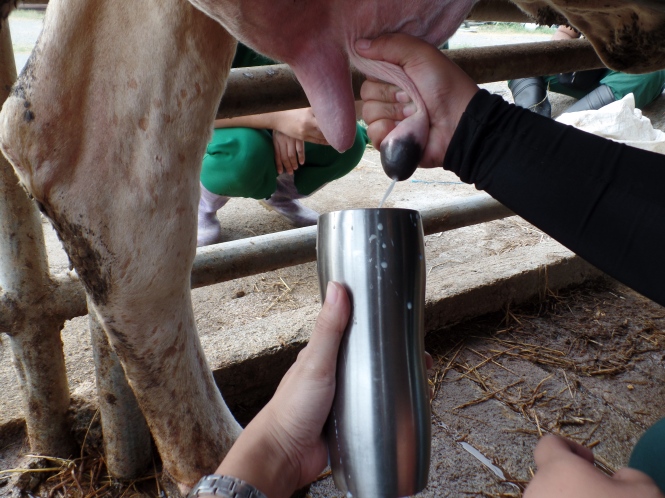
Day 8, January 25, 2017.
8AM. HR Department. Due to unforeseen changes in the schedule, we had to extend our stay in PCC, Nueva Ecjia for another week. We went to the Human Resource department to request for an extension. Sir Mark told us to simply submit a letter.
10AM. Patient treatment. We checked Theodore. It still tries to stand but has no strength to do so. It still has good appetite, which is a good thing. We placed it again in a cow lifter to help it stand. We administered a Vitamin B Complex supplement (Betamyl©) and Calcium carbonate + Vitamin D3 supplement (Calvitam©). We also gave it fresh grass and water.
11:30PM. Farm rounds. As we went on rounds in the farm, we noticed one heifer that cannot stand and is also quite lethargic. Doc Jim decided to transfer it to an individual pen. However since all individual pens were filled, we place it inside Theodore’s pen. Its animal ID is C112. It was inappetent and nasal discharge was visible. We suspected that it had the similar case with Theodore. We gave IV D5 Lactate Ringer’s Solution via jugular vein. We also administered Marbofloxacin and Flunixine Meglumine (Flunivet©). After which, we administered a Vitamin B Complex supplement (Betamyl©) and Calcium carbonate + Vitamin D3 supplement (Calvitam©). We gave it fresh grass but it was inappetent. Doc Jim said that inappetence is a sign of the first phase of disease.

1PM. Deworming and Vitamins Administration. We started to deworm the animals using Albendazole (Penalvet©) 15% and gave them Retinol + Cholecalciferol + DL-a-tocopherol vitamins. We herded the animals from their pens into the chute. It involves a lot of running and jumping over fences. It was easy since water buffaloes have a submissive attitude; they were extremely large and heavy but they were completely scared of humans. Once inside the chute, we will restrain its head using a rope and then administer the drugs. Water buffaloes in the GP farm are not used in being handled which is why t takes the strength of almost 4 people to restrain just its head.

Restraining strength is needed!

Herding!

Vitamins

Dewormer
We then herd them back to their respective pens. We were able to finish more or less 50 heads. It was such a tiring , dirty and super fun day!
Day 9, January 26, Thursday.
9AM. Patient treatment. We did a follow up check up on Theodore and we were happy because he was already standing up! We did not have to place him in the cow lifter anymore. It seems it was on its way to full recovery. We also used wound sprays on all the affected areas. However, animal no. C112 seemed to be more lethargic than yesterday. It was able to stand up but it was not moving. It was still depressed and inappetent.
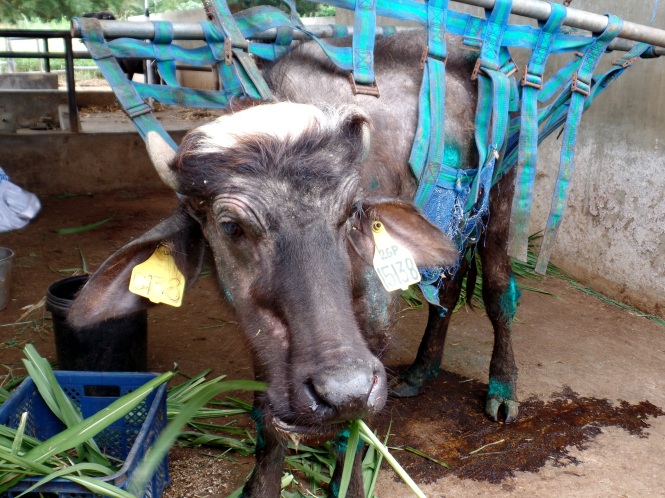
10AM. Deworming and Vitamins Administration. Since we were not able to finish all the animals yesterday, we finished them today. We started to deworm and administer Vitamins to the bulls and caracows at around 10AM and finished at around 3PM. I learned the definition of tiring and dirty and draining. Haha!

SAMSUNG CAMERA PICTURES

SAMSUNG CAMERA PICTURES
Day 10, January 27. Friday
9AM. Patient treatment.We started doing rounds around the farm. We checked Theodore today. He was standing and walking around his pen. Although a slight difficulty in walking can still be visible. Animal C112 is still lethargic and is still a downer.
11:30PM. Rumenotomy. I am very excited because it is my first time to conduct rumenotomy in a large ruminant and this time we even did two! Rumenotomy is the surgical opening of the rumen by making the incision on its wall. It is indicated in cases of ruminal impaction, frothy bloat, diaphragmatic hernia, foreign body ingestion and exploratory laparotomy. Today is the scheduled rumenotomy for two animals: Y166 and W78. Their cases are both foreign body ingestion, specifically they ingested the ropes used to bundle up the hay they eat.
Weeks before the surgery, the farm boys noticed that their fecal consistency varied from day to day. The veterinarian decided to do an ultrasound and confirmed the foreign body. The animals were fasted from grass and silage for three days prior to the surgery giving them only concentrates and water.

Field Surgery starter pack.
First we herded the two animals from their individual pens into the chute. We then gave them a bath using high-pressure water to remove the mud and other dirt in the left side of their flank since this is the area of incision. After which, we shaved the area and cleaned it with Iodine solution.
Doc Cyril and Doc Jim are the surgeons while all of us assisted. Animal no. Y166 was first up. The surgery is performed in a standing animal. Local anesthesia is done by giving 20mL of Lidocaine in the paravertebral area. In paravertebral anesthesia T13, 1L and L2 nerves are blocked. Aside from that, Inverted L technique was also done using 20mL Lidocaine. After 20-25 minutes, the first skin incision was made. The site of incision is equidistant from tubercoxae and the last rib beginning 5 cm ventral to the lumbar transverse process. Dissection of the subcutaneous fascia and oblique muscles continues to the transverse abdominis muscle. Allis tissue forceps was used to keep the incision open. The length of incision from skin to the peritoneum should be in descending order to facilitate closure. Also, the skin incision should be wide enough to allow the surgeon’s arm inside the abdomen. A fold of rumen is exteriorized. A plastic drape was placed to prevent spillage of the ruminal contents into the abdominal cavity. A stay suture is placed at the 3, 6, 9 and 12 o clock positions to prevent the rumen form going back inside the abdominal cavity and also, to prevent contamination. After fixation, the rumen is incised longitudinally in a vertical direction. Large amount of digested material were present so doc Cyril had to manually evacuate it. The whole arm is then inserted and the entire rumen, reticulum, reticulo-ruminal fold were explored. Every now and then, the suture site and exposed area is irrigated with normal saline solution to prevent the organ from drying. After a few minute of exploration, as expected, a rope was found. Surprisingly, Doc Cyril was also able to palpate an almost full-grown fetus. We were not aware that the animal was actually pregnant.
After exploration, the rumen was closed by double row of continuous inverting sutures using chromic catgut no. 3. The stay sutures are removed and the rumen is re-placed inside the cavity. The peritoneum was then closed using a catgut no. 3 in a simple continuous suture pattern. The muscles were also sutured using catgut no. 3 in a simple continuous suture pattern as well. The skin was sutured using a silk suture in a simple interrupted pattern. The area is cleaned with iodine solution. Dried blood were removed as this can attract flies. We administered Tolfenamic acid as analgesic. The surgery ended at around 2:30PM.
4PM. 2nd Rumenotomy. After we had our lat lunch, we started another rumenotomy on animal W78. Like the animal Y116, variation on its feces were also observed and ultrasound was also performed. The same procedure was carried out. One thing I will surely remember is that the chute area where we were performing the surgery has no available lights. We had to use our phone lights to illuminate the procedure.

Surgery in the dark.
At around 6PM, the animal lied down which made the surgery more difficult. We were all tired from the whole day of standing and restraining. It is not seen in the picture above but there is actually 8 people doing the surgery. It was 8PM and it was VERY cold and windy in the farm, no lights were available so we had to use our phones’ flash lights. What I learned in performing surgery in the field is that you always have to be resourceful, use what is available, adjust to changes and keep the animal alive. It was around 8:30PM and the procedure was finally done! If I am not mistaken, this is the latest time we went home.We had dinner with doc Jim on a nearby eatery.
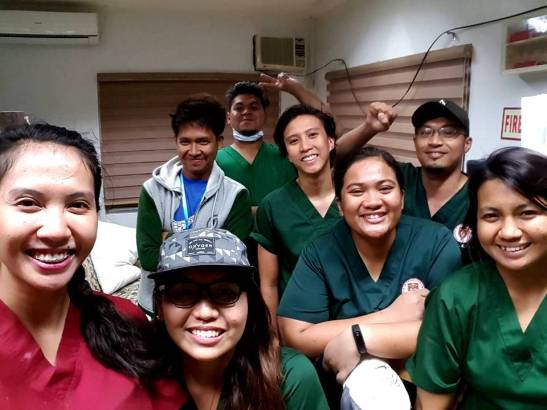
National Gene Pool division week is over!
Our second week in PCC is officially over! It is Saturday and I am sipping my coffee as I am writing this entry. Two straight weeks here in Nueva Ecija is such a joy. I am really loving its very “province feels”! Next week we are assigned in the National Impact Zone (NIZ) division where we will be visiting different farms around Nueva Ecija that is connected with PCC. I am really looking forward to it since we get to go to places and get a chance to talk to farmers and businessmen alike.

